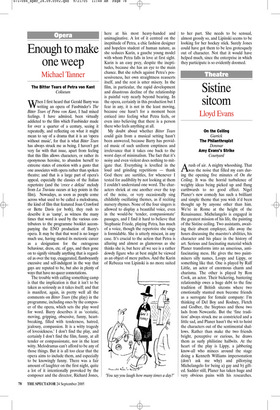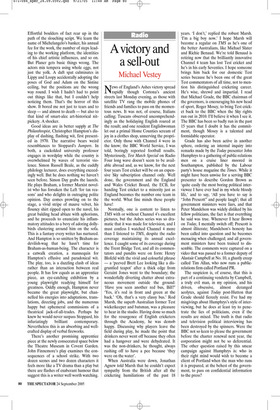Sistine sitcom
Lloyd Evans
On the Ceiling Garrick The Philanthropist Donmar Amy Evans’s Strike Courtyard Arush of air. A mighty whooshing. That was the noise that filled my ears during the opening five minutes of On the Ceiling. It was the horrid turbulence of weighty ideas being picked up and flung earthwards to no good effect. Nigel Planer’s new comedy has such a brilliant and simple theme that you wish it’d been thought up by anyone other than him. We’re in Rome at the height of the Renaissance. Michelangelo is engaged in the greatest mission of his life, the painting of the Sistine ceiling. Two assistants, awaiting their absent employer, idle away the hours discussing the maestro’s abilities, his character and his place in the history of art. Serious and fascinating material which Planer transforms into an unserious, antifascinating mess. He gives the two paintmixers silly names, Loopy and Lippy, or something like that. One is played by Ralf Little, an actor of enormous charm and charisma. The other is played by Ron Cook, an actor. Their bickering, bantering relationship owes a huge debt to the fine tradition of British sitcoms where two emotionally stunted men become friends as a surrogate for female company: I’m thinking of Del Boy and Rodney, Fletch and Godber, the Steptoes and those two lads from Newcastle. But the ‘fine tradition’ always struck me as constricted and a little sad, and Planer hasn’t the wit to hoist the characters out of the sentimental shallows. Rather than make the two friends bright, perceptive or curious, he draws them as surly philistine halfwits. At the heart of the play is Lippy, a jabbering know-all who minces around the stage doing a Kenneth Williams impersonation (don’t ask me why) and pillorying Michelangelo for being a) gay and b) gifted. Sadder still, Planer has taken huge and very obvious pains with his researches. Effortful boulders of fact rear up in the path of the slouching script. We learn the name of Michelangelo’s banker, his annual fee for the work, the number of steps leading to the working platform, the identities of his chief artistic influences, and so on. But Planer gets basic things wrong. The actors mix tempera using whole eggs, not just the yolk. A daft spat culminates in Lippy and Loopy accidentally adopting the poses of God and Adam on the Sistine ceiling, but the positions are the wrong way round. I wish I hadn’t had to point out things like that, but I couldn’t help noticing them. That’s the horror of this show. It bored me not just to tears and to sleep — and almost to death — but also to that kind of smart-alec art-historical nitpickery. A shocker.
Good ideas are in better supply at The Philanthropist, Christopher Hampton’s display of dashing, flashing wit, first presented in 1970. The narrative bears weird resemblances to Stoppard’s Jumpers. In both, a cuckolded university professor engages in wordplay while the country is overwhelmed by waves of terrorist violence. Simon Russell Beale, as the cuddly philology lecturer, does everything exceedingly well. But he does nothing we haven’t seen before. Simon Day grabs the laurels. He plays Braham, a former Marxist novelist who has forsaken the Left ‘for tax reasons’ and who delights in outraging polite opinion. Day comes prowling on to the stage, a vivid stripe of mauve velvet, his flouncy shirt ripped open to the navel, his great balding head ablaze with aphorisms, and he proceeds to enunciate his inflammatory attitudes to a bevy of adoring dollybirds clustering around him on the sofa. This is a fantasy every writer has nurtured. And Hampton is so smitten by Braham-asdevilish-wag that he hasn’t time for Braham-as-human-being. The character is a catwalk creation, a mannequin for Hampton’s effusive and paradoxical wit. The play, too, is a dazzling clash of ideas rather than an interaction between real people. It has few equals as an apprentice piece, an eye-catching exhibition by a young playwright readying himself for greatness. Oddly enough, Hampton never became the great playwright, but channelled his energies into adaptations, translations, directing jobs, and the numerous happy but ephemeral commissions of a theatrical jack-of-all-trades. Perhaps he knew he would never surpass Stoppard, his infuriatingly brilliant contemporary. Nevertheless this is an absorbing and wellcrafted display of verbal fireworks.
There’s another promising apprentice piece at the newly consecrated space below the Theatre Museum in Covent Garden. John Finnemore’s play examines the consequences of a school strike. With two dozen scenes and two dozen characters it feels more like a TV drama than a play but there are flashes of exuberant humour that suggest this is a writer well worth watching.

































































 Previous page
Previous page